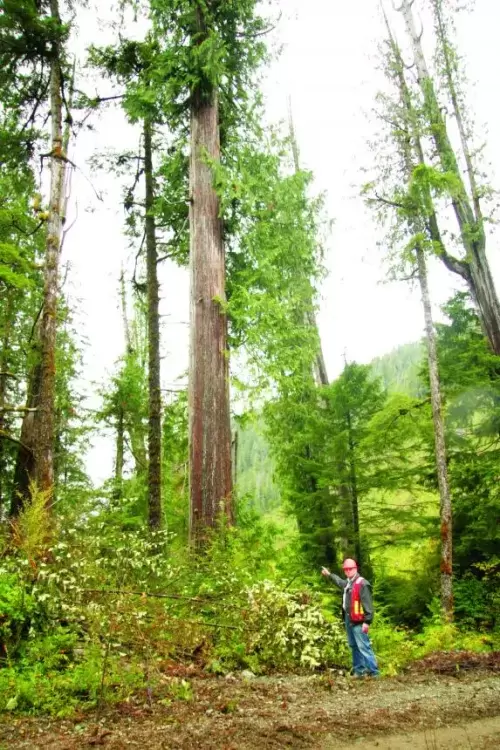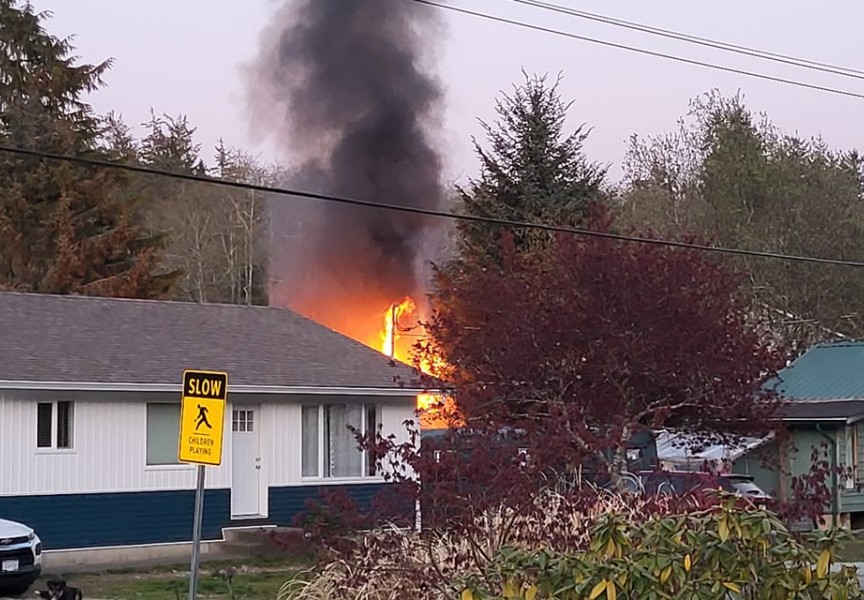It seems an age ago now. In fact, not quite nine years have passed since representatives of Greenpeace, the Natural Resources Defence Council, the Sierra Club and the Western Canada Wilderness Committee sat down in Tofino and helped usher in a new era in forestry in British Columbia.
It was the culmination of years of protest, peaking in the summer of 1993, when more than 16,000 people rallied on the logging roads of Clayoquot Sound and turned back an industrial juggernaut that threatened to consume what was left of Vancouver Island’s last remaining stands of old-growth. In the process, more than 800 of those people were arrested.
As a CBC television reporter at the time, I was witness to those events. In fact, my first reporting in Clayoquot dated back to 1987 and the standoff at Sulphur Passage, and continued through 1994, when I left the CBC to help launch Ecotrust Canada.
In the aftermath of the summer of 1993, a number of important things occurred:
First, the Nuu-chah-nulth First Nations assumed a leadership role in deliberations about the future of all resource development in Clayoquot–something they had hitherto been denied.
Second, the government of the day promised to introduce “world-class” forestry in Clayoquot Sound. A blue-chip Scientific Panel for Sustainable Forestry Practices in Clayoquot Sound was struck. Importantly, its co-chair was Umeek, Ahousaht hereditary chief Richard Atleo, and the 1995 report that emerged from the science panel was remarkable for its expression of a First Nations worldview of forestry.
Third, a new forest company, Iisaak Forest Resources, emerged from the wreckage of years of industrial forestry, in the form of a joint venture between the central region chiefs and MacMillan Bloedel (M&B).
In June of 1999, Greenpeace et al sat down in Tofino and signed a Memorandum of Understanding with Iisaak Forest Resources. Later that year, the Tree Farm Licence that used to belong to M&B was transferred to Iisaak. This was a radical departure from past practice, giving the Clayoquot chiefs a majority interest in a tenure in their territory for the first time.
The ENGOs supported Iisaak because the company committed to observing the strict forestry standards demanded by the science panel, which by definition meant Iisaak would cut a lot less wood than in the past. The company also committed to achieving Forest Stewardship Council certification, and to managing “eehmiis,” or precious areas (pristine watersheds, in other words) emphasizing non-timber values.
One assumes that everyone who signed the MOU did so in the full realization that some logging would resume in Clayoquot Sound. Indeed, the ENGOs committed to “actively promoting” Iisaak products, and otherwise supporting Iisaak’s operations.
Ecotrust Canada was not a signatory to the MOU, so we were under no perceived or actual obligation to assist Iisaak in any way. However, Ecotrust Canada’s purpose is “to build a conservation economy,” which values people, the planet and profits.
We have been active in Clayoquot Sound since the early 1990s. In our view, Iisaak seemed to represent everything the environmental community, and First Nations, had fought so hard to achieve, a First Nations majority-owned forest company with its own tenure, managed according to science panel principles, producing FSC-certified forest products, and providing good livelihoods for local people, including First Nations people. This seemed to us to be the triple-bottom-line in action.
In its first year of operations, Iisaak needed working capital and so we provided a start-up loan through our recently launched business finance program.
We also assisted Iisaak in its bid to gain FSC certification, which it achieved in 2001. Ecotrust Canada also provided financial advice to the chiefs when they bought out Iisaak’s minority shareholder in 2005, taking sole proprietorship of the company
I’m not sure what the other environmentalists were doing to support Iisaak’s operations and/or promote its products, but Ecotrust Canada contributed our talents and resources as best we could to enable a living, breathing example of sustainable forestry to, well, sustain itself.
At this point the chiefs owned 100 per cent of a company that was struggling. Industry, remember, has long maintained that the science panel principles are unworkable because they impose high costs spread over low volumes–anathema to gluttons who got fat on precisely the reverse.
We believe the science panel principles are workable. In any event, there are plenty of people out there who would be happy to see Iisaak fail, because it would support their contention that environmentalists have imposed unrealistic standards, that First Nations don’t have the capacity to manage their own forest companies, that FSC doesn’t really fly in the marketplace, and that the good old days were just that.
Late in 2005, Iisaak decided it needed new management and Ecotrust Canada won the contract to manage Iisaak in a competitive process. Since November of 2006, we have been in the management seat of Iisaak, assisted by Triumph Timber, which is the only company on the BC coast that has ever harvested according to anything like an ecosystem-based management standard.
The results so far? Iisaak has made a remarkable turnaround and is making a profit for the first time since 2000. After almost losing its FSC certification, that has been restored. Of Iisaak’s some 40 employees and contractors, two-thirds are local, and just less than half are First Nations. Iisaak has also recently hired a local First Nations management-level employee for the first time.
I’ve flown over cutblocks in the Fortune Channel area between Kennedy Lake and Meares Island. These were 40 per cent retention stands, which means 60 per cent of the cutblock had been harvested. From down on the water looking up, it is virtually impossible to detect that the forest has been harvested at all, while an old clearcut is all-too-visible in the foreground.
Iisaak is also committed not to high-grade cedar and not to cut just big trees. That means the company leaves behind after logging the same proportion of cedar, and range of tree sizes, that existed in the original forest.
In fact, a recent post-harvest timber cruise in Rankin Cove showed that we took less cedar than we could have. That’s perhaps bad business, since cedar is so valuable, but it shows the caution the company is practicing in its harvesting.
In recent months, Ecotrust Canada has been condemned in some circles for the work we have done with the Nuu-chah-nulth in Clayoquot Sound. Iisaak’s name may be native but the people behind the company are not, says one critic.
We think that Iisaak’s employment figures speak for themselves. I’ve also heard the refrain that Forest Stewardship Council certification is “a scam.” Well, if that’s the case, it is a scam of the environmentalists’ own making, since a lot of people worked very hard to produce a standard for sustainable forestry.
Our work is far from done. We want Iisaak to be successful. By that we mean we want the chiefs to own a company that builds prosperity in their communities, that logs less, adds more value, realizes the multiple benefits of ecosystem services (including tourism, water, non-timber forest products, and hopefully carbon) and contributes to long-term stability in the region.
The company will need to confront the fact, sooner than later, that even its much reduced harvest level (compared to the 1990s) may well be too high in the long term, especially if the “eehmiis” areas are netted out of its timber harvesting land base.
Why do we do this?
Because the world is full of talk about sustainability, and precious little action. Environmentalists have a long and proud history of opposing all sorts of developments that have dreadful consequences for the health of our planet, and the people who call it home. Regretfully, we are often mute when it comes to articulating a development vision of our own, and even when we do craft what appear to be solutions, environmentalists have a habit of abandoning them.
FSC is a classic example: years of work went into developing local standards for sustainable forestry, but guess what? That means that some trees, including old-growth trees, will be harvested. FSC? Good in principle, but suddenly folks get weak at the knees when it is put into practice. The Science Panel? A huge breakthrough, but somehow not good enough?
Ecotrust Canada does not believe for a moment that we have all the answers, or even many of them. But we are compelled to act because answers don’t come from sitting back and savaging good-faith attempts to build new models of human conduct on our planet. Answers come from taking risks, assessing successes and being honest about failures. We are prepared to do all of that, and more.
We invite criticism, and assuredly we will get it. We already have. On an online environmental forum where recent criticism of our work has surfaced, many of the authors of various postings like to append an epigram to their musings, often quoting the likes of Gandhi, Rachel Carson, John Muir, or Margaret Mead. I don’t remember anyone else quoting Maxim Gorky, but consider this:
“The madness of the brave is the wisdom of life.”
I think it is a brave thing that Iisaak is attempting. I think it is a brave thing that Ecotrust Canada is attempting. Quite possibly mad, too, as has been suggested by one critic. But through this work, we seek to find wisdom, and to share it. It is a currency that is barely in circulation in our society. It should be the cornerstone of our economy. It is the foundation of a conservation economy.
For more information on Iisaak’s operations, visit our blog at ecotrustcanada.blogspot.com or search “Iisaak” on Youtube to view a five-minute video for an aerial view of the ecoforestry in Clayoquot Sound.
By Ian Gill
President of Ecotrust Canada







